
Concept explainers
The coefficients of friction between the 30-lb block and the 5-lb platform BD are μs = 0.50 and μk = 0.40. Determine the accelerations of the block and of the platform immediately after wire AB has been cut.
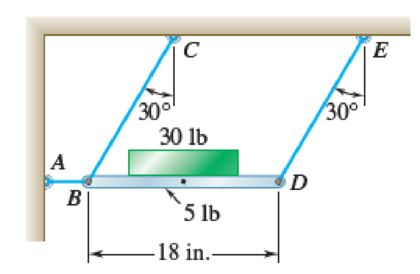
Fig. P16.20
Calculate the accelerations of the block and of the platform immediately after wire AB has been cut
Answer to Problem 16.20P
The accelerations of the block and of the platform immediately after wire AB has been cut
Explanation of Solution
Given information:
The weight of the block
The weight of the platform BD
The coefficients of static friction
The coefficients of kinetic friction
The length of the platform BD (L) is
Calculation:
Consider the acceleration due to gravity (g) is
Consider the block does not slide relative to the platform.
Show the free body and kinetic diagram of the platform and block as in Figure 1.
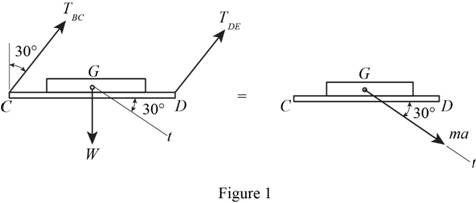
Here,
Refer to Figure 1.
Calculate the forces at the tangent:
Substitute
Calculate the acceleration of the block and of the platform (a):
Substitute and
Check whether or not the block will slide relative to the platform.
Show the free body and kinetic diagram of the block as in Figure 2.
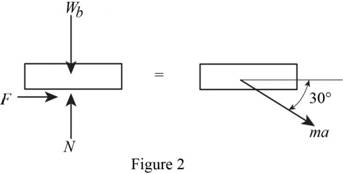
Here, F is the horizontal force of the block and N is the vertical force of the block.
Refer to Figure 2
Calculate the horizontal forces by applying the equation of equilibrium:
Substitute
Substitute
Calculate the vertical forces by applying the equation of equilibrium:
Substitute
Substitute
Calculate the force of the block
Substitute 0.50 for
Since, the block will slide.
Consider the block slides relative to the platform.
Calculate the Equations of motion for block:
Show the free body and kinetic diagram of the block as in Figure 3.
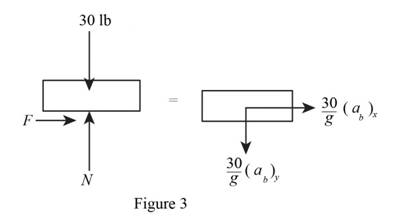
Here,
Refer to Figure 3
Calculate the vertical forces by applying the equation of equilibrium:
Calculate the horizontal forces by applying the equation of equilibrium:
Substitute
Substitute 0.40 for
Calculate the Equations of motion for platform:
Show the free body and kinetic diagram of the platform as in Figure 4.
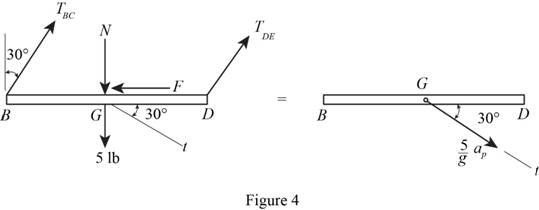
Here,
Refer to Figure 4
Calculate the forces at the tangent:
Substitute
If contact is maintained between block and platform.
Therefore,
Calculate the vertical force of the block (N):
Substitute
Calculate the acceleration of the block at x direction
Substitute
Calculate the acceleration of the block at y direction
Substitute
Calculate the accelerations of the block
Substitute
Calculate the angle of the block
Substitute
Calculate the accelerations of the platform
Substitute
Calculate the angle of the platform
Substitute
Hence, the accelerations of the block and of the platform immediately after wire AB has been cut
Want to see more full solutions like this?
Chapter 16 Solutions
VEC MECH 180-DAT EBOOK ACCESS(STAT+DYNA)
Additional Engineering Textbook Solutions
Starting Out with Java: From Control Structures through Objects (7th Edition) (What's New in Computer Science)
Starting Out with C++ from Control Structures to Objects (9th Edition)
Web Development and Design Foundations with HTML5 (8th Edition)
Mechanics of Materials (10th Edition)
SURVEY OF OPERATING SYSTEMS
Automotive Technology: Principles, Diagnosis, And Service (6th Edition) (halderman Automotive Series)
- reading is 0.4 mas SHOWN. Assume h₁ = 0.4 m, h₂ = 0.5 m. (a) Do you know the specific weight of mercury? (b) Do you know the specific weight of gasoline? (c) Do you know the specific weight of oil? (a) YHg = 133,000 (b) Ygas = 6867 (c) Yoil = 8829 eTextbook and Media Part 2 N/m³ N/m³ N/m³ A+ Gasoline t +B Oil -Mercury Attempts: unlimited Did you calculate the pressure difference between two locations using the correct specific weight? Did you assume that the pressures in fluid are the same in a horizontal plane even though they are in different tubes? Are the calculated pressures in a column of fluid always higher at lower elevations? Did you account for the fact that the two horizontal tubes of the U-tube are above the ground? Concepts: The pressure in a fluid is a function of the specific weight of the fluid and the height relative to a reference. Pressure is constant in a horizontal plane of a continuous mass of fluid. (a) What is the initial pressure difference? (PA-PB) (b) What is…arrow_forwardFind the solution of the following Differential Equations 1) "-4y+3y=0 3) "+16y=0 2) y"-16y=0 4) y"-y-6y=0 5) y"+2y=0 7) y"+y=0, (#0) 9) y"-y=0, y(0) = 6, y'(0) = -4 11) y"-4y+3y=0, y(0)=-1, 13) y'(0) = -5 "+2y+2y=0 15) y"-9y=0 17) y"-4y=0 6) y"-2y+2y=0 8) "+4y+5y=0 10) y"-9y=0, y(0) = 2, y'(0) = 0 12) y"-3y+2y= 0, y(0)=-1, y'(0) = 0 14) 4y+4y+y=0 16) "+6y+12y=0 18) 4y+4y+17y=0arrow_forwardAccess Pearson Mastering Engineering Back to my courses Course Home Course Home Scoresarrow_forward
- Access Pearson Mastering Engineering Back to my courses Course Home Course Home Scores Review Next >arrow_forwardAccess Pearson Course Home Scoresarrow_forwardAccess Pearson Mastering Engineering Back to my courses Course Home Course Home Scoresarrow_forwardarrow_back_iosSEE MORE QUESTIONSarrow_forward_ios
 Elements Of ElectromagneticsMechanical EngineeringISBN:9780190698614Author:Sadiku, Matthew N. O.Publisher:Oxford University Press
Elements Of ElectromagneticsMechanical EngineeringISBN:9780190698614Author:Sadiku, Matthew N. O.Publisher:Oxford University Press Mechanics of Materials (10th Edition)Mechanical EngineeringISBN:9780134319650Author:Russell C. HibbelerPublisher:PEARSON
Mechanics of Materials (10th Edition)Mechanical EngineeringISBN:9780134319650Author:Russell C. HibbelerPublisher:PEARSON Thermodynamics: An Engineering ApproachMechanical EngineeringISBN:9781259822674Author:Yunus A. Cengel Dr., Michael A. BolesPublisher:McGraw-Hill Education
Thermodynamics: An Engineering ApproachMechanical EngineeringISBN:9781259822674Author:Yunus A. Cengel Dr., Michael A. BolesPublisher:McGraw-Hill Education Control Systems EngineeringMechanical EngineeringISBN:9781118170519Author:Norman S. NisePublisher:WILEY
Control Systems EngineeringMechanical EngineeringISBN:9781118170519Author:Norman S. NisePublisher:WILEY Mechanics of Materials (MindTap Course List)Mechanical EngineeringISBN:9781337093347Author:Barry J. Goodno, James M. GerePublisher:Cengage Learning
Mechanics of Materials (MindTap Course List)Mechanical EngineeringISBN:9781337093347Author:Barry J. Goodno, James M. GerePublisher:Cengage Learning Engineering Mechanics: StaticsMechanical EngineeringISBN:9781118807330Author:James L. Meriam, L. G. Kraige, J. N. BoltonPublisher:WILEY
Engineering Mechanics: StaticsMechanical EngineeringISBN:9781118807330Author:James L. Meriam, L. G. Kraige, J. N. BoltonPublisher:WILEY





